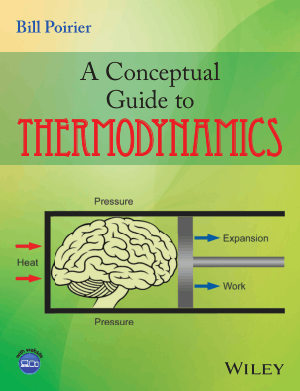My goal with this book is to provide the undergraduate student in chemical engineering
with the solid background to perform thermodynamic calculations with
confidence, and the course instructor with a resource to help students achieve this
goal. The intended audience is sophomore/junior students in chemical engineering.
The book is divided into two parts. Part I covers the laws of thermodynamics,
with applications to pure fluids; Part II extends thermodynamics to mixtures, with
emphasis on phase and chemical equilibrium. The selection of topics was guided
by the realities of the undergraduate curriculum, which gives us about 15 weeks
per semester to develop the material and meet the learning objectives. Given that
thermodynamics requires some minimum “sink-in” time, the deliberate choice was
made to prioritize topics and cover them at a comfortable pace. Each part consists
of seven chapters, corresponding to an average of about two weeks (six lectures) per
chapter. Under such restrictions certain topics had to be left out and for others their
coverage had to be limited. Highest priority is given to material that feeds directly to
other key courses of the curriculum: separations, reactions, and capstone design. A
deliberate effort was made to stay away from specialty topics such as electrochemical
or biochemical systems on the premise that these are more appropriately dealt with
(and at a depth that a book such as this could do no justice) in physical chemistry,
biochemistry, and other dedicated courses. Students are made aware of the amazing
generality of thermodynamics and are directed to other fields for such details as
needed. A theme that permeates the book is the molecular basis of thermodynamics.
Discussions of molecular phenomena remain at a qualitative level (except for
very brief excursions to statistical concepts in the chapter on entropy), consistent
with the background of the typical sophomore/junior. But the molecular picture is
consistently brought up to reinforce the idea that the quantities we measure in the
lab and the equations that describe them are manifestations of microscopic effects
at the molecular level.
The two parts of the book essentially mirror the material of a two-course
sequence in thermodynamics that is typically required in chemical engineering. The
focus of Part I is on pure fluids exclusively. The PVT behavior is introduced early on
(Chapter 2) so that when it comes to the first and second law (Chapters 3 and 4),
students have the tools to perform basic calculations of enthalpy and entropy using
steam tables (a surrogate for tabulated properties in general) and equations of
state. Chapter 5 discusses fundamental relationships and the calculation of properties
from equations of state. It is mathematically the densest chapter of Part I.
xiii
xiv Preface
Chapter 6 goes into applications of thermodynamics to chemical processes. The
range of applications is limited to systems involving pure fluids, namely power
plants and refrigeration/liquefaction systems. This is the part of the course that
most directly relates to processes discussed in capstone design and justifies the
“Chemical Engineering” in the title of the book. It is one of the longer chapters,
with several examples and end-of-chapter problems. The last chapter in this part
covers phase equilibrium for a single fluid and serves as the connector between the
two parts, as fugacity is the main actor in Part II.
The second part begins with a survey of phase diagrams of binary and simple
ternary systems. It introduces the variety of phase behaviors of mixtures and
establishes the notion that each phase at equilibrium has its own composition, and
introduces the lever rule as a basic material balance tool. Many programs probably
cover some of that material in the Materials and Energy Balances course but
the topics are central to subsequent discussions so that a separate chapter is justified.
Chapter 9 extends the fundamental relationships, which in Part I were applied
to pure fluids, to mixtures. This chapter also introduces the equation of state for
mixtures and the calculation of mixture properties from the equation of state. Chapter
10 is a short chapter that establishes the phase equilibrium criterion for mixtures
and applies the equation of state to calculate the phase diagram of a binary mixture.
Chapters 11 and 12 deal with ideal and nonideal solutions, respectively. Chapter 13
goes over several topics of phase equilibrium that are too small to be in separate
chapters. These include partial miscibility, solubility of gases and solids, and osmotic
processes. The last chapter in this part, 14, covers reaction equilibrium. The focus of
the chapter is to establish the fundamental relationships, which are then applied to
single and multiphase reactions. Standard states are discussed in quite some detail,
since this is a topic that seems to confuse students.
Overall, a great effort has been made to balance theory with examples and
applications. Examples cover a wide range, from direct application of formulas and
methodologies, to larger processes that require synthesis of several smaller problems.
It has been my experience that students are more willing to accept what they
perceive as abstract theory if they can see how this theory is tied to practical
industrial situations. Realistic problems are rarely of the paper-and-pencil type, and
this brings up the need for mathematical/computational tools. The choices today are
many, from sophisticated hand calculators to spreadsheets and numerical packages.
The textbook takes an agnostic approach when it comes to the type of software
and leaves it up to the instructor to make that choice. Typically, the problems that
require numerical tools are those involving calculations with equations of state.
Some problems lend themselves to the use of process simulators but, by deliberate
decision, there is no specific mention of these simulators in the book. As with the
other computational tools, the choice is left to the instructor. In my experience, the
Preface xv
best approach with problems that require a significant number of computations is to
assign them as projects. Picking problems with industrial flavor not only motivates
students in engineering, it also offers convincing justification for the practical need
for theory and numerical methodologies.









